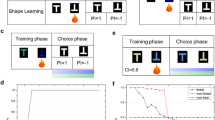Abstract
To adapt to the environment and survive, most animals can control their behaviors by making decisions. The process of decision-making and responding according to cues in the environment is stable, sustainable, and learnable. Understanding how behaviors are regulated by neural circuits and the encoding and decoding mechanisms from stimuli to responses are important goals in neuroscience. From results observed in Drosophila experiments, the underlying decision-making process is discussed, and a neural circuit that implements a two-choice decision-making model is proposed to explain and reproduce the observations. Compared with previous two-choice decision making models, our model uses synaptic plasticity to explain changes in decision output given the same environment. Moreover, biological meanings of parameters of our decision-making model are discussed. In this paper, we explain at the micro-level (i.e., neurons and synapses) how observable decision-making behavior at the macro-level is acquired and achieved.


















Similar content being viewed by others
References
Ananthanarayanan R, Modha DS (2007) Anatomy of a cortical simulator. In: Proceedings of the 2007 ACM/IEEE conference on supercomputing. ACM, p 3
Bell CC, Han VZ, Sugawara Y, Grant K (1997) Synaptic plasticity in a cerebellum-like structure depends on temporal order. Nature 387(6630):278–281
Bi G-Q, Poo M-M (1998) Synaptic modifications in cultured hippocampal neurons: dependence on spike timing, synaptic strength, and postsynaptic cell type. J Neurosci 18(24):10464–10472
Bogacz R, Brown E, Moehlis J, Holmes P, Cohen JD (2006) The physics of optimal decision making: a formal analysis of models of performance in two-alternative forced-choice tasks. Psychol Rev 113(4):700
Bohte SM, Poutré HL, Kok JN (2002) Unsupervised clustering with spiking neurons by sparse temporal coding and multilayer RBF networks. IEEE Trans Neural Netw 13(2):426–435
Busemeyer JR, Townsend JT (1993) Decision field theory: a dynamic-cognitive approach to decision making in an uncertain environment. Psychol Rev 100(3):432
Carandini M (2012) From circuits to behavior: a bridge too far? Nat Neurosci 15(4):507–509
Eliasmith C, Stewart TC, Choo X, Bekolay T, DeWolf T, Tang Y, Rasmussen D (2012) A large-scale model of the functioning brain. Science 338(6111):1202–1205
Foderaro G, Henriquez C, Ferrari S (2010) Indirect training of a spiking neural network for flight control via spike-timing-dependent synaptic plasticity. In: 49th IEEE conference on decision and control (CDC). IEEE, pp 911–917
Gerstner W, Kempter R, van Hemmen JL (1996) A neuronal learning rule for sub-millisecond temporal coding. Nature 383:76–78 (LCN-ARTICLE-1996-002)
Izhikevich EM, Edelman GM (2008) Large-scale model of mammalian thalamocortical systems. Proc Nat Acad Sci 105(9):3593–3598
Izhikevich EM et al (2003) Simple model of spiking neurons. IEEE Trans Neural Netw 14(6):1569–1572
Li X, Chen Q, Xue F (2016) Bursting dynamics remarkably improve the performance of neural networks on liquid computing. Cognit Neurodyn 10(5):415–421
Markram H (2006) The blue brain project. Nat Rev Neurosci 7(2):153–160
Markram H, Lübke J, Frotscher M, Sakmann B (1997) Regulation of synaptic efficacy by coincidence of postsynaptic APs and EPSPs. Science 275(5297):213–215
Natschläger T, Ruf B (1998) Spatial and temporal pattern analysis via spiking neurons. Netw Comput Neural Syst 9(3):319–332
Nishiyama M, Hong K, Mikoshiba K, Poo M-M, Kato K (2000) Calcium stores regulate the polarity and input specificity of synaptic modification. Nature 408(6812):584–588
Qu J, Wang R, Yan C, Du Y (2014) Oscillations and synchrony in a cortical neural network. Cognit Neurodyn 8(2):157–166
Ratcliff R (1978) A theory of memory retrieval. Psychol Rev 85(2):59
Ratcliff R, Rouder JN (1998) Modeling response times for two-choice decisions. Psychol Sci 9(5):347–356
Samura T, Ikegaya Y, Sato YD (2015) A neural network model of reliably optimized spike transmission. Cognit Neurodyn 9(3):265–277
Tang S, Guo A (2001) Choice behavior of drosophila facing contradictory visual cues. Science 294(5546):1543–1547
Usher M, McClelland JL (2001) The time course of perceptual choice: the leaky, competing accumulator model. Psychol Rev 108(3):550
Vickers D (1970) Evidence for an accumulator model of psychophysical discrimination. Ergonomics 13(1):37–58
Waldrop MM (2012) Computer modelling: brain in a box. Nature 482(7386):456–458
Wang X-J (2002) Probabilistic decision making by slow reverberation in cortical circuits. Neuron 36(5):955–968
Wittenberg GM, Wang SS-H (2006) Malleability of spike-timing-dependent plasticity at the CA3-CA1 synapse. J Neurosci 26(24):6610–6617
Zhang K, Guo JZ, Peng Y, Xi W, Guo A (2007) Dopamine-mushroom body circuit regulates saliency-based decision-making in drosophila. Science 316(5833):1901–1904
Zhang X, Xu Z, Henriquez C, Ferrari S (2013) Spike-based indirect training of a spiking neural network-controlled virtual insect. In: IEEE 52nd annual conference on decision and control (CDC). IEEE, pp 6798–6805
Zhao J, Deng B, Qin Y, Men C, Wang J, Wei X, Sun J (2016) Weak electric fields detectability in a noisy neural network. Cognit Neurodyn 11:81–90
Acknowledgements
This work was supported by NSFC project (Project No.61375122), and in part by Shanghai Science and Technology Development Funds (Grant Nos. 13dz2260200, 135115 04300). We thank LetPub (www.letpub.com) and Accdon for their linguistic assistance during the preparation of this manuscript. The authors declare that there is no conflict of interest regarding the publication of this paper.
Author information
Authors and Affiliations
Corresponding author
Rights and permissions
About this article
Cite this article
Wei, H., Bu, Y. & Dai, D. A decision-making model based on a spiking neural circuit and synaptic plasticity. Cogn Neurodyn 11, 415–431 (2017). https://doi.org/10.1007/s11571-017-9436-2
Received:
Revised:
Accepted:
Published:
Issue Date:
DOI: https://doi.org/10.1007/s11571-017-9436-2



